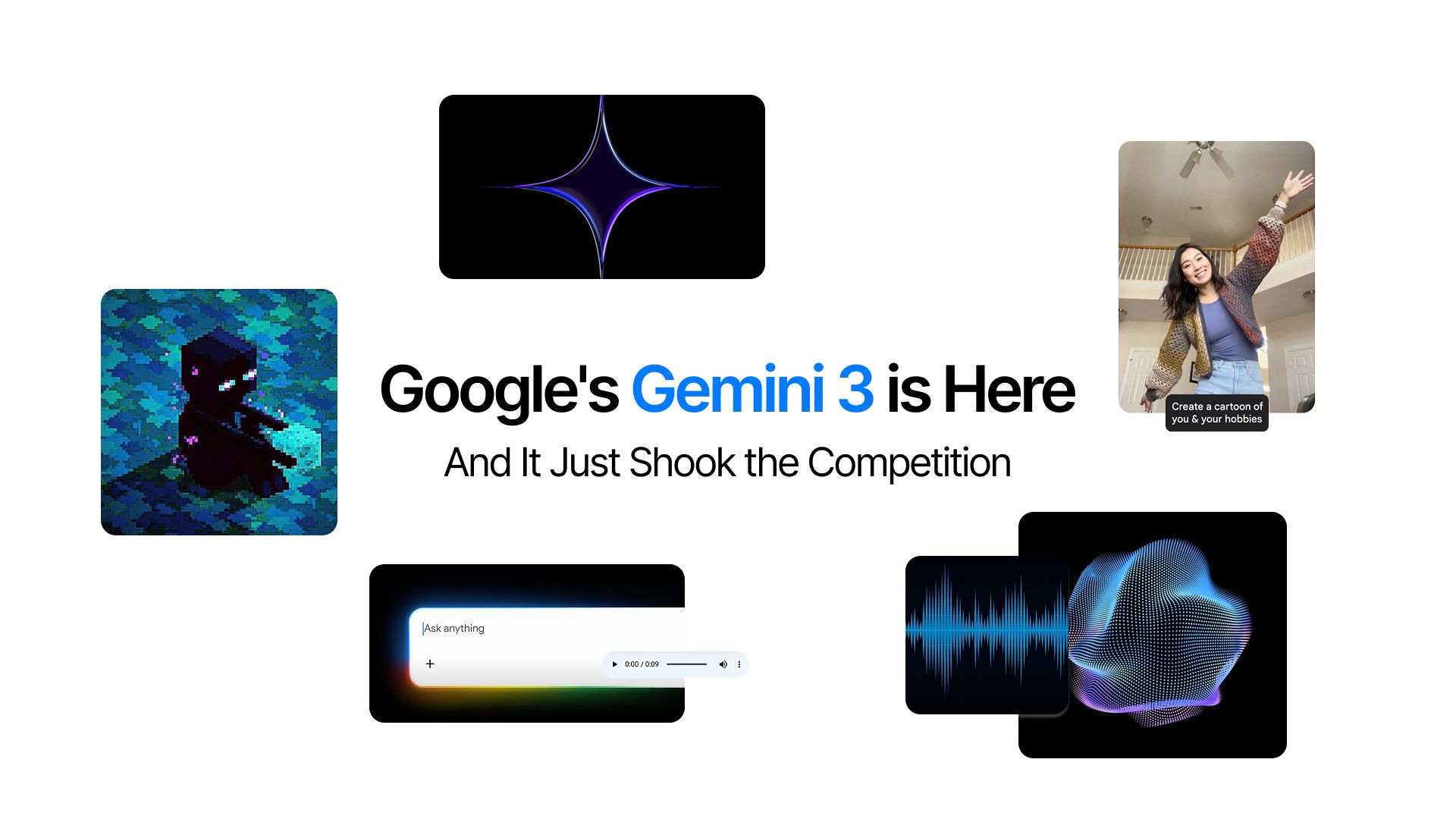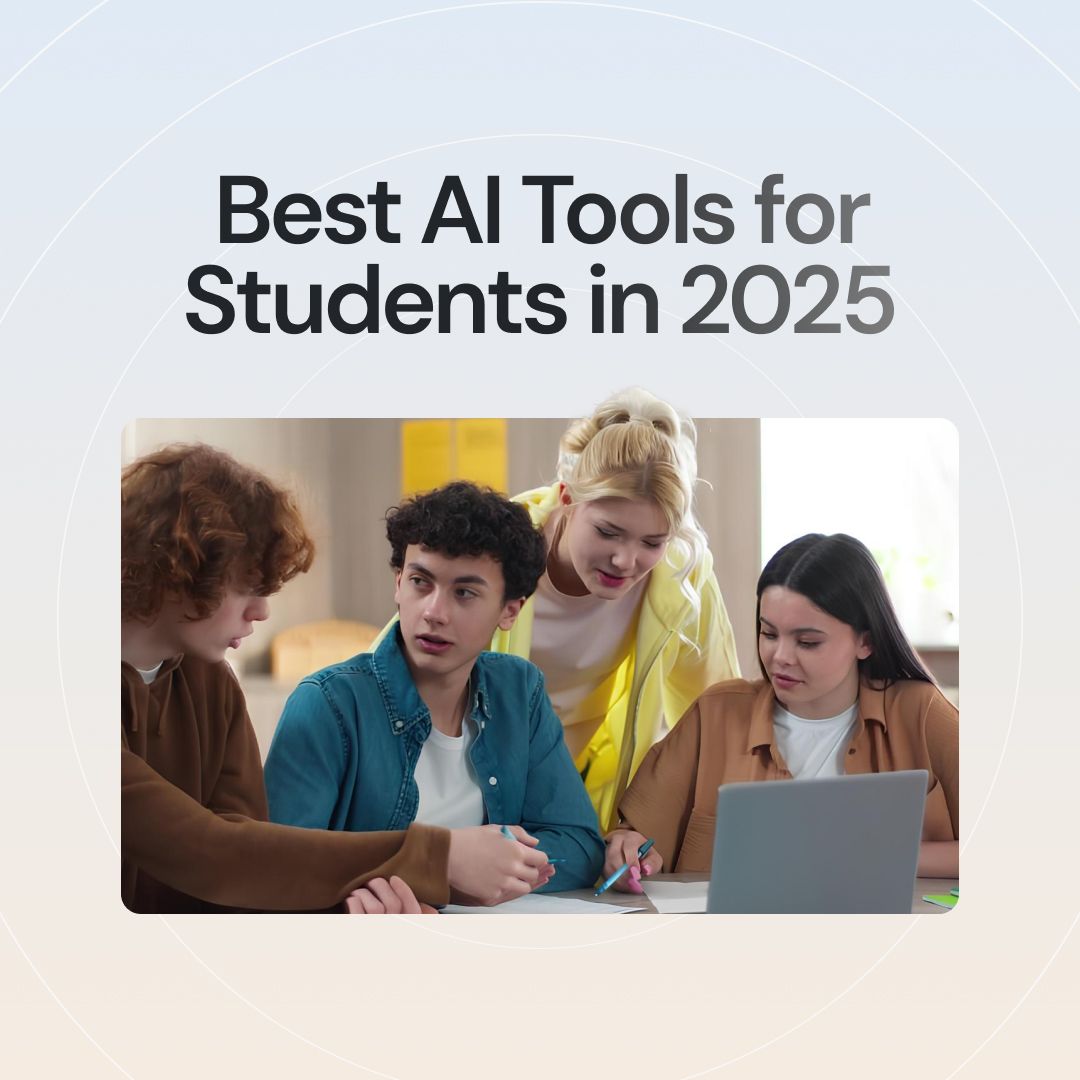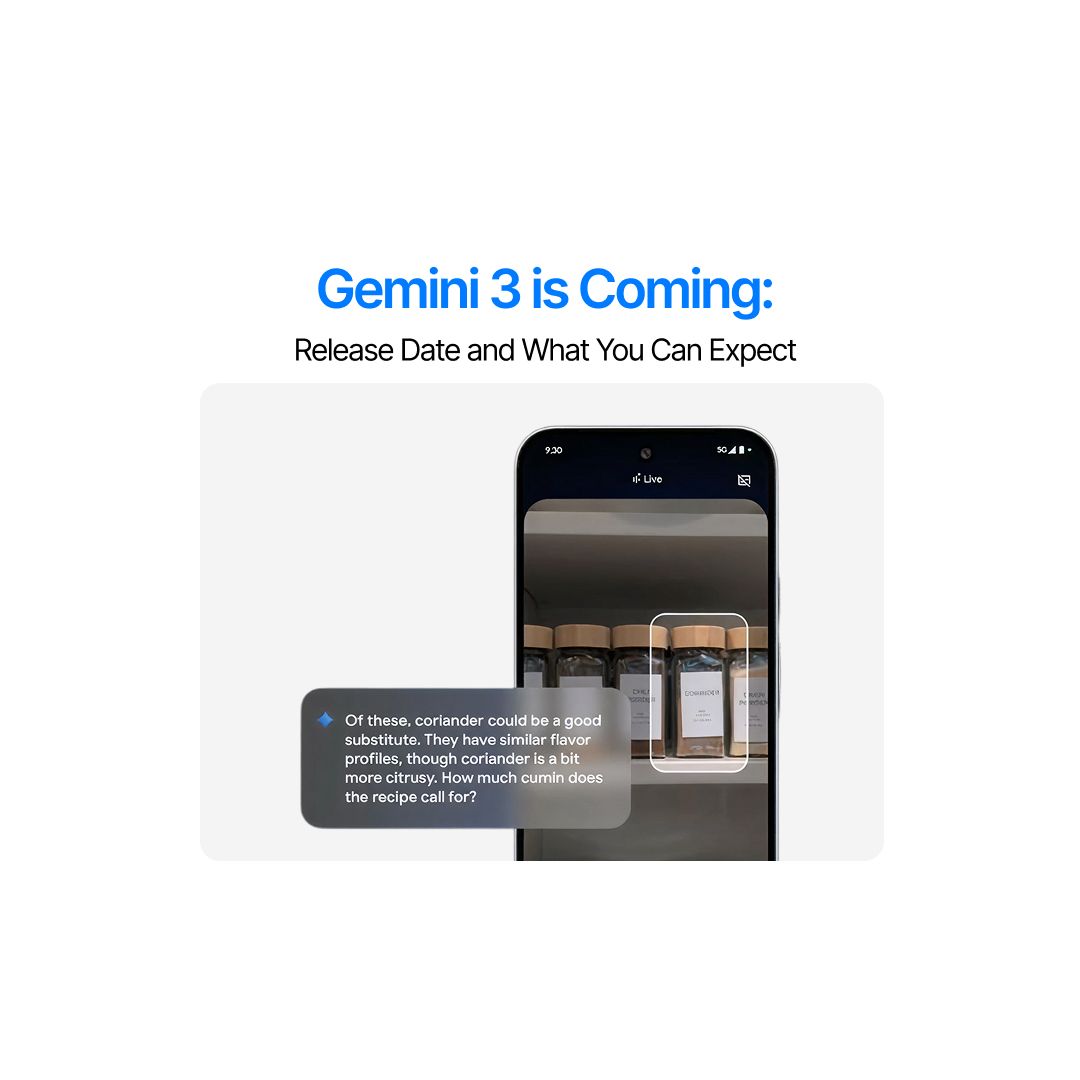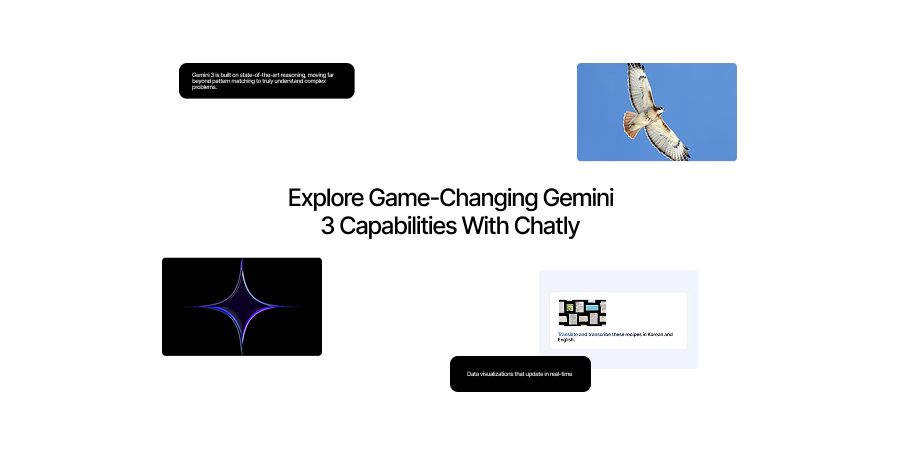
Google's Gemini 3 is Here (And It Just Shook the Competition)
For the past few months (especially since GPT-5.1 released), one thing that had been on people’s minds was Gemini 3’s release date.
And the wait is finally over. Gemini 3 is here and it has changed the race.
Google unveiled Gemini 3 on November 18, 2025 and the response was enthusiastic (to say the least). The hype wasn't merely marketing bluster; it was backed by an avalanche of benchmark results that indicate genuine breakthrough capabilities.
Google’s Gemini 3 represents a shift in how we think about AI and AI Chat— moving from models that assist with tasks to autonomous agents that can plan, execute, and complete complex, multi-step workflows over extended periods.
In this blog, we will take a look at Gemini 3’s astonishing benchmark results, what it means, and new capabilities that make it a significant leap forward among the competition.
A Model That Impresses (Even the Competition)
It’s rare to come across genuine praise from a competitor in a field where billions of dollars and market positioning are at stake. CEOs typically downplay rival releases, emphasize their own differentiators, or simply remain silent.
Which is what made Sam Altman's response to Gemini 3 so noteworthy.
The OpenAI CEO took to X (formerly Twitter) to acknowledge Google Gemini 3 as "a great model." For the head of OpenAI to publicly praise a direct competitor's model speaks volumes about Gemini 3's actual capabilities.
The tweet sparked immediate discussion across tech forums, with developers and researchers parsing what it meant for the competitive landscape.
Industry analysts noted that Altman's acknowledgment likely reflected internal assessments showing Gemini 3 Pro outperforming GPT-5.1 across numerous benchmarks. This legitimizes Gemini 3’s superiority over recent AI models from all competitors.
Introducing Gemini 3: Google's Most Ambitious AI Yet
Gemini 3 is built on a fundamentally different architecture than its predecessors. While Gemini 2.5 Pro was already highly capable, Gemini 3 Pro incorporates breakthrough advances in several critical areas:
Gemini 3 is built on state-of-the-art reasoning, moving far beyond pattern matching to truly understand complex problems. Its ability to break tasks into components, explore multiple solution paths, and choose the best strategy reflects a deep, structured approach to intelligence.
What sets Google Gemini 3 apart is its multimodal fusion and agentic capabilities. It synthesizes text, images, audio, video, and code simultaneously, while Gemini 3 Pro can plan and execute multi-step workflows autonomously across tools.
With a massive 1-million-token context window, it can handle codebases, long documents, and extended tasks with remarkable continuity.
The model family includes two primary variants:
- Gemini 3 Pro: The standard flagship model, optimized for a balance of capability, speed, and cost-efficiency across a wide range of tasks.
- Gemini 3 Deep Think: An enhanced reasoning mode that allocates additional computational resources to solve extremely complex problems, delivering step-change improvements in reasoning and multimodal understanding for the hardest challenges.
The Gemini 3 Ecosystem: A Complete Platform for the Agentic Future
One of the most significant aspects of the Gemini 3 launch isn't just the model itself but the comprehensive ecosystem Google built around it. Google delivered a complete platform vision for how AI agents will transform software development and problem-solving.
Google Antigravity
A crucial part of this ecosystem is Google Antigravity, a revolutionary new agentic development platform.
Traditional integrated development environments (IDEs) have evolved to incorporate AI assistance like in GitHub Copilot, Claude Code, or cursor's AI features. In these tools, AI agents sit inside the editor as helpful assistants, suggesting code completions, explaining functions, or answering questions.
Antigravity flips this paradigm entirely.
Rather than embedding AI agents within traditional development tools, Antigravity embeds traditional development tools—the editor, terminal, and browser—within an agent-first environment. The agents have been elevated to a dedicated surface with direct access to all development resources, allowing them to autonomously plan and execute complex, end-to-end software tasks while validating their own work.
1. The Architecture of Agent-First Development
Antigravity is built around two primary surfaces, intentionally separated to match different development modes:
-
The Editor View offers a full IDE experience with syntax highlighting, tab completions, and in-line commands, plus agents accessible from a side panel. It’s ideal for developers who want hands-on coding while getting targeted AI assistance.
-
The Manager Surface enables orchestrating and monitoring multiple agents across different workspaces. Here, developers set goals and constraints while agents handle execution autonomously.
Switching between these views reflects real workflow needs—sometimes you want direct control, and other times you want to delegate entire tasks to agents.
2. Trust Through Artifacts
One of the biggest challenges with AI agents is the "black box problem." How do you verify what an agent is doing without drowning in technical details? Antigravity solves this elegantly through Artifacts.
As agents work, they produce artifacts in formats that developers can easily verify. These artifacts provide context at a natural, task-level abstraction. You're not watching raw API calls or debugging logs (unless you want to), but you're also not completely blind to what's happening.
3. Autonomy at Scale
Agents in Antigravity operate with genuine autonomy across the editor, terminal, and browser. They can:
- Plan complex software tasks by breaking them into manageable steps
- Write and edit code across multiple files
- Execute terminal commands to test, build, and deploy
- Operate browsers to validate functionality and capture results
- Adapt their approach based on outcomes
Critically, these agents can run for extended periods without human intervention—hours, not minutes. This enables delegation of substantial work, not just quick automation.
4. Asynchronous Feedback
In most AI coding assistants, providing feedback means stopping the agent, making corrections, and restarting. If an agent completes 80% of a task but makes an error in the final 20%, you often end up spending more time fixing issues than the agent saved.
Antigravity introduces asynchronous feedback mechanisms that feel like collaborating with a remote team member:
- Add Google Doc-style comments directly on text artifacts
- Use select-and-comment feedback on screenshots
- Annotate task lists and implementation plans
- Provide guidance without interrupting execution
Agents incorporate this feedback into their ongoing work, course-correcting without requiring complete restarts.
5. Self-Improvement Through Learning
Perhaps most ambitiously, Antigravity includes built-in self-learning capabilities. Agents can:
- Retrieve information from development knowledge bases
- Contribute back to shared knowledge as they work
- Learn from past successful task completions
- Abstract not just code snippets but entire problem-solving approaches
Over time, agents become more effective at organization-specific patterns, frameworks, and conventions.
Generative UI: AI That Creates Rich Interactive Experiences
Another groundbreaking capability in the Gemini 3 ecosystem is Generative UI .It offers the ability for AI to create rich, custom, visual, and interactive user experiences entirely based on natural language prompts.
This goes far beyond generating static content or simple visualizations. Generative UI can create:
- Complete web pages with dynamic layouts
- Interactive games and simulations
- Custom tools tailored to specific tasks
- Data visualizations that update in real-time
There is more.
- Google Search (AI Mode): For U.S. Google AI Pro and Ultra subscribers, Gemini 3 powers dynamic, generative search experiences. Queries can return visually organized layouts, interactive tools like calculators or timelines, and simulations tailored to topics such as physics concepts or historical events.
- Gemini App: The mobile and web app offers experimental generative interfaces with Dynamic View, creating fully functional, custom apps for prompts like workout planners or project trackers, and Visual Layout, producing magazine-style, visually rich information displays. These features showcase Google’s vision for AI interfaces beyond chat, providing immersive, interactive experiences.
Gemini Agent
Available as an experimental feature for Google AI Ultra subscribers in the U.S., Gemini Agent showcases Gemini 3's advanced reasoning applied to real-world productivity.
Unlike simple task automation, Gemini Agent handles complex, multi-step tasks by connecting to Google apps and services:
- Gmail integration: Organize inbox, draft replies, categorize messages, create follow-up reminders
- Calendar management: Schedule meetings, find optimal times, send invitations, manage conflicts
- Deep Research: Unmatched AI Search abilities to conduct comprehensive research across multiple sources, synthesize findings, create reports
The key differentiator is multi-app orchestration. Rather than performing isolated tasks within single applications, Gemini Agent can work across Google's ecosystem, maintaining context and goals throughout complex workflows.
Developer Tools: Comprehensive API and SDK Access
Google ensured Gemini 3 Pro is immediately accessible across the development ecosystem:
1. Gemini API Updates
The Gemini API in Google AI Studio and Vertex AI received major enhancements:
- Client-Side Bash Tool: Empowers the model to propose shell commands as part of agentic workflows, enabling sophisticated automation and system interaction.
- Server-Side Bash Tool: Hosted execution environment for multi-language code generation and secure prototyping without requiring local setup.
- Grounding + Structured Outputs: The ability to combine hosted tools (like Grounding with Google Search and URL context) with structured output formats is particularly powerful for agentic use cases involving data fetching and extraction.
2. Google AI Studio
Google AI Studio is positioned as "the fastest path from a prompt to an AI-native app." The concept of vibe coding is fully realized here.
Developers can literally prompt: "Create a recipe finder app that searches by ingredients I have on hand, with dietary restrictions filtering, and a shopping list export feature" and receive a working application with both frontend interface and backend logic.
This isn't code generation that still requires assembly and debugging; it's end-to-end application creation.
3. Firebase AI Logic Client SDKs
For mobile and web developers, Firebase AI Logic Client SDKs provide direct access to the Gemini 3 Pro preview via the Gemini API across multiple platforms:
- Android
- Flutter
- Web (JavaScript/TypeScript)
- iOS (Swift)
- Unity (game development)
Firebase also provides an AI monitoring dashboard offering comprehensive visibility into:
- AI usage patterns and volume
- Cost tracking and optimization
- Latency measurements and performance
- Error rates and debugging information
This enterprise-grade observability is essential for production deployments.
4. Third-Party Integrations
Gemini 3 Pro is being rapidly integrated into the tools developers already use:
- Cursor: The popular AI-first code editor
- GitHub: Direct integration with the world's largest code hosting platform
- JetBrains IDEs: IntelliJ IDEA, PyCharm, WebStorm, and others
- Manus: Emerging agentic coding platform
- Replit: Cloud-based development environment
- Gemini CLI: Full command-line interface for terminal-based workflows
This broad integration strategy ensures developers can access Gemini 3's capabilities within their existing workflows rather than requiring wholesale tool changes.
Enterprise: Vertex AI and Gemini Enterprise
For enterprise teams, Gemini 3 Pro is available through two primary channels:
Vertex AI: Google Cloud's comprehensive AI platform offering:
- Enterprise-grade security and compliance
- Private deployment options
- Integration with Google Cloud services
- Custom training and fine-tuning capabilities
- Dedicated support and SLAs
Gemini Enterprise: An advanced agentic platform specifically designed for teams to:
- Create custom AI agents for specific business workflows
- Share agents across organizations securely
- Run multi-agent workflows at scale
- Maintain governance and access control
- Monitor usage and ROI
These enterprise offerings acknowledge that large organizations need comprehensive platforms with security, governance, and operational capabilities.
The Benchmarks: Proving Excellence Through Data
Marketing claims are easy. Backing them up with real data is the real deal.
That’s what Google did with Gemini 3. It doesn't just compete with the best models from OpenAI and Anthropic but it consistently outperforms them, often by substantial margins.
Let’s have a look at some of the most important benchmarks.
1. Humanity's Last Exam
This benchmark represents some of the most challenging reasoning problems humans face, spanning graduate-level questions across diverse domains including advanced mathematics, scientific reasoning, philosophy, logical puzzles, and complex analytical tasks.
Results:
- Gemini 3 Deep Think: 41%
- Gemini 3 Pro: 37.5%
- GPT-5.1: 26.5%
- Claude Sonnet 4.5: 13.7%
- Gemini 2.5 Pro: 21.6%
The performance gap here is substantial. Gemini 3 Deep Think achieves a score that's 55% better than GPT-5.1 and nearly 3x better than Claude Sonnet 4.5. Even the standard Gemini 3 Pro outperforms all competitors.
2. GPQA Diamond
The Graduate-Level Google-Proof Q&A Diamond subset is specifically designed to test expert-level scientific knowledge in biology, physics, and chemistry. Questions are written by PhD-level domain experts and validated to ensure they're difficult even for specialists.
"Google-proof" means the answers aren't easily findable through simple web searches and require genuine understanding of scientific principles and the ability to apply them to novel scenarios.
Results:
- Gemini 3 Deep Think: 93.8%
- Gemini 3 Pro: 91.9%
- GPT-5.1: 88.1%
- Gemini 2.5 Pro: 86.4%
- Claude Sonnet 4.5: 83.4%
All frontier models perform well on this benchmark, but Gemini 3 establishes clear leadership. The Deep Think mode's 93.8% score represents near-mastery of graduate-level scientific reasoning.
3. ARC-AGI-2
The Abstraction and Reasoning Corpus for Artificial General Intelligence (ARC-AGI) is arguably the most important benchmark for measuring progress toward human-like general intelligence.
Results:
- Gemini 3 Deep Think (with tools on): 45.1%
- Gemini 3 Pro: 31.1%
- GPT-5.1: 17.6%
- Gemini 2.5 Pro: 4.9%
These results are nothing short of stunning. Gemini 3 Deep Think with tool access achieves a score that's:
- 156% better than GPT-5.1
- 821% better than Gemini 2.5 Pro
Even Gemini 3 Pro without the Deep Think mode scores 31.1%, nearly double GPT-5.1's performance.
4. MMMU-Pro
The Massive Multi-Discipline Multimodal Understanding Pro benchmark evaluates complex multimodal reasoning across images, text, and specialized knowledge in fields like science, engineering, art history, business, and medicine.
Results:
- Gemini 3 Pro: 81.0%
- Claude Sonnet 4.5: 68.0%
- Gemini 2.5 Pro: 68.0%
- GPT-5.1: 76.0%
Gemini 3 Pro achieves 81%, establishing a clear lead over all competitors. The 13-point advantage over Claude and Gemini 2.5 Pro, and 5-point lead over GPT-5.1, demonstrates superior ability to synthesize across modalities.
5. Video-MMMU
This benchmark tests models on knowledge acquisition from video content across diverse domains.
Results:
- Gemini 3 Pro: 87.6%
- Gemini 2.5 Pro: 83.6%
- Claude Sonnet 4.5: 77.8%
- GPT-5.1: 80.4%
Gemini 3 Pro achieves the highest score, demonstrating industry-leading video understanding. While all frontier models perform reasonably well (suggesting video understanding has matured across the field), Gemini 3 maintains its lead.
6. AIME 2025
The American Invitational Mathematics Examination is an annual competition for high school students who have excelled in earlier rounds of the Mathematical Association of America competitions. It features 15 extremely challenging problems requiring creative mathematical thinking, not just formula application.
These aren't plug-and-chug problems. They demand multiple insight leaps, clever problem-solving strategies, and the ability to synthesize concepts from different mathematical domains.
Results:
- Gemini 3 Pro (no tools): 95.0%
- Gemini 3 Pro (with code execution): 100%
- Claude Sonnet 4.5 (with code execution): 100%
- GPT-5.1: 94.0%
- Gemini 2.5 Pro: 88.0%
- Claude Sonnet 4.5 (no tools): 87.0%
Gemini 3 Pro achieves a perfect 100% score when allowed to use code execution, matching Claude Sonnet 4.5's perfect performance. This demonstrates that when given appropriate tools, Gemini 3 can solve even the most challenging high school mathematics problems flawlessly.
7. MathArena Apex
These are problems from prestigious competitions like the International Mathematical Olympiad, Putnam Competition, and advanced research mathematics.
Success on these problems requires not just knowledge but genuine mathematical creativity and insight.
Results:
- Gemini 3 Pro: 23.4%
- Gemini 2.5 Pro: 0.5%
- Claude Sonnet 4.5: 1.6%
- GPT-5.1: 1.0%
The results here are jaw-dropping. Gemini 3 Pro achieves 23.4% on problems where competitors essentially fail:
- 46.8x better than Gemini 2.5 Pro
- 14.6x better than Claude Sonnet 4.5
- 23.4x better than GPT-5.1
These represent a completely different class of mathematical capability.
8. LiveCodeBench Pro
This benchmark evaluates competitive programming ability using problems from platforms like Codeforces, AtCoder, and TopCoder. These are algorithmic challenges that require:
- Understanding complex problem specifications
- Designing efficient algorithms
- Implementing solutions in working code
- Optimizing for time and space complexity
The benchmark uses Elo ratings to rank model performance, similar to chess rankings.
Results:
- Gemini 3 Pro: 2,439 Elo (highest score)
- GPT-5.1: 2,243 Elo
- Claude Sonnet 4.5: 1,418 Elo
- Gemini 2.5 Pro: 1,775 Elo
Gemini 3 Pro's 2,439 Elo rating establishes it as the clear leader in competitive programming. The 196-point advantage over GPT-5.1 and massive 1,021-point lead over Claude demonstrates superior algorithmic thinking and code generation.
9. SWE-Bench Verified
SWE-Bench uses real GitHub issues and pull requests to evaluate whether models can contribute meaningfully to actual open-source projects.
Results:
- Claude Sonnet 4.5: 77.2%
- Gemini 3 Pro: 76.2%
- GPT-5.1: 76.3%
- Gemini 2.5 Pro: 59.6%
This is one of the few benchmarks where Gemini 3 Pro doesn't lead, though it's essentially tied with Claude Sonnet 4.5 and GPT-5.1 in the 76-77% range. All three frontier models demonstrate strong real-world software engineering capabilities.
Revolutionary Capabilities: The Technology Behind the Performance
The benchmark results demonstrate what Gemini 3 can do. But understanding how it achieves these results reveals why this model represents a genuine paradigm shift rather than incremental improvement.
1. Advanced Reasoning Architecture
Gemini 3 is built on state-of-the-art reasoning designed to understand depth and nuance in complex problems, moving beyond pattern-matching approaches typical of traditional transformers.
While Google hasn’t revealed full architectural details, performance indicates several key innovations:
- Multi-Step Reasoning: The model breaks complex problems into subproblems, explores multiple solution paths, and evaluates approaches before producing answers.
- Thought Signatures: Encrypted representations of internal reasoning preserve context across conversation turns, allowing agents to maintain coherent strategies and preventing context drift.
- Configurable Thinking: Developers can adjust "thinking levels" for depth of reasoning and "thinking budgets" to balance computational cost and latency.
- Deep Think Mode: Allocates maximum resources for intensive analytical tasks, ensuring the model can tackle problems requiring thorough deliberation.
These features enable Gemini 3 to handle multi-turn, complex tasks efficiently while giving developers control over resource use and response quality.
2. Massive 1 Million Token Context Window
Gemini 3’s 1 million-token context window sets a new standard, enabling applications that were previously impossible for AI models with limited memory. This massive capacity allows the model to maintain context, analyze complex data, and reason over extended sequences.
- Entire Codebase Analysis: Gemini 3 can process hundreds of files across large repositories, understanding architecture, dependencies, and cross-file interactions.
- Long-Form Video Processing: Hours of transcribed video content can be analyzed for patterns, summaries, and insights spanning long temporal sequences.
- Book-Length Document Analysis: Academic papers, legal texts, and reports can be processed in full, enabling accurate, comprehensive understanding without chunking.
- Extended Conversation History: Agents can maintain weeks or months of project context, ensuring continuity in long-running, multi-turn workflows.
3. True Multimodal Architecture
While many models claim "multimodal" capabilities, most are fundamentally text models with vision capabilities bolted on. Gemini 3 appears to process multiple modalities natively, synthesizing across them rather than converting non-text inputs to text descriptions.
Enhanced Document and Spatial Understanding: Gemini 3 goes beyond OCR by interpreting document layouts, table structures, and semantic relationships between visual and textual elements, achieving a top-tier 0.115 score on OmniDocBench.
4. Advanced Media Processing
Gemini 3 introduces granular control over multimodal vision processing via the “media_resolution” parameter in the API. Developers can specify:
- Higher resolution processing: For documents with fine text or images with small details requiring pixel-level precision
- Standard resolution: For general images where detail is less critical, saving computational resources
- Optimized resolution: Letting the model automatically select appropriate resolution based on content type
The new default higher resolution improves the model's ability to read fine print in documents, identify small objects in images, and process detailed diagrams—addressing a common limitation where AI models struggled with text embedded in images.
5. Advanced Tool Use and Planning
Effective agents need to use tools—calculators, search engines, code execution environments, APIs, and specialized services. Gemini 3 is specifically trained to:
- Identify when tools are needed: Recognizing that a problem requires capabilities beyond pure reasoning—searching for current information, executing code for precise calculations, or calling APIs for specialized data.
- Select appropriate tools: Choosing the right tool for each subtask from available options.
- Use tools correctly: Formulating proper queries, providing correct parameters, and handling tool-specific requirements.
- Interpret results: Understanding tool outputs and incorporating them into ongoing reasoning.
- Orchestrate multi-tool workflows: Combining multiple tools in sequence or parallel to accomplish complex goals.
The 85.4% score on t2-bench demonstrates best-in-class tool use capabilities. More impressively, the Gemini API includes both client-side and server-side bash tools, enabling sophisticated system interaction:
- Client-side bash tool: Proposes shell commands as part of agentic workflows, allowing the agent to suggest system operations while keeping execution control with the user.
- Server-side bash tool: Hosted execution environment where the agent can run multi-language code generation and secure prototyping, expanding capabilities beyond what's possible in pure language model inference.
The ability to combine hosted tools (like Grounding with Google Search and URL context) with structured outputs is particularly powerful for agentic use cases involving data fetching and extraction—for example, researching topics, extracting specific data points, and returning results in structured JSON format.
6. Long-Horizon Task Execution
The Vending-Bench 2 results ($5,478 vs competitors' $1,473-$3,839) demonstrate Gemini 3's most impressive agentic capability: sustained strategic coherence over extended periods.
Long-horizon tasks require:
- Strategic consistency: Maintaining goals and priorities across hundreds of decisions
- Adaptation: Responding to changing circumstances without abandoning core strategy
- Learning from outcomes: Adjusting approaches based on what works and what doesn't
- Avoiding drift: Not gradually losing focus or changing objectives arbitrarily
Most AI models struggle with long-context tasks because they lack mechanisms for maintaining strategic intent. They might make good individual decisions but fail to optimize for long-term outcomes.
Gemini 3's training specifically emphasizes long-horizon planning, and the results validate this focus. For enterprise applications where agents will operate over days, weeks, or months—managing projects, optimizing operations, or handling customer relationships—this capability is transformative.
Security and Safety
Google emphasizes that Gemini 3 is their "most secure model yet," having undergone the most comprehensive set of safety evaluations of any Google AI model to date.
While specific evaluation details aren't fully public, this likely includes:
- Red Teaming: Adversarial testing to identify potential misuse vectors
- Bias and Fairness Evaluation: Testing for demographic biases and ensuring equitable performance
- Harmful Content: Evaluating refusal capabilities for dangerous or illegal requests
- Jailbreak Resistance: Testing robustness against prompt injection and manipulation attempts
- Privacy Protection: Ensuring the model doesn't leak training data or sensitive information
The Deep Think mode is undergoing additional safety evaluations before broader release, acknowledging that enhanced reasoning capabilities might create novel safety considerations that require extra scrutiny.
This cautious, thorough approach to safety reflects lessons learned across the industry about responsible AI deployment.
Conclusion
Google Gemini 3 represents a major leap forward in AI, combining state-of-the-art reasoning, massive context capacity, true multimodal understanding, and advanced agentic capabilities.
From autonomous software development with Antigravity to generative UIs, long-horizon task execution, and enterprise-grade tool integrations, Gemini 3 is designed to handle complex, real-world workflows at scale.
Benchmarks across reasoning, mathematics, multimodal comprehension, and competitive programming confirm its leadership over current frontier models, while its robust safety and security measures ensure responsible deployment.
With Gemini 3, Google isn’t just advancing AI—it’s redefining how intelligent agents can assist, collaborate, and create across industries.
Frequently Asked Question
Learn what question people have been asking about Google's Gemini 3.
More topics you may like

11 Best ChatGPT Alternatives (Free & Paid) to Try in 2025 – Compare Top AI Chat Tools

Muhammad Bin Habib

24/7 Customer Support with AI Chat: Benefits, Examples and More

Muhammad Bin Habib

28 Best AI Tools for Students in 2025 – The Complete AI-Powered Academic Success Guide

Muhammad Bin Habib

10 Different Ways You Can Use Chatly AI Chat and Search Every Day

Faisal Saeed

When is Gemini 3 Coming Out and What to Expect?

Faisal Saeed
